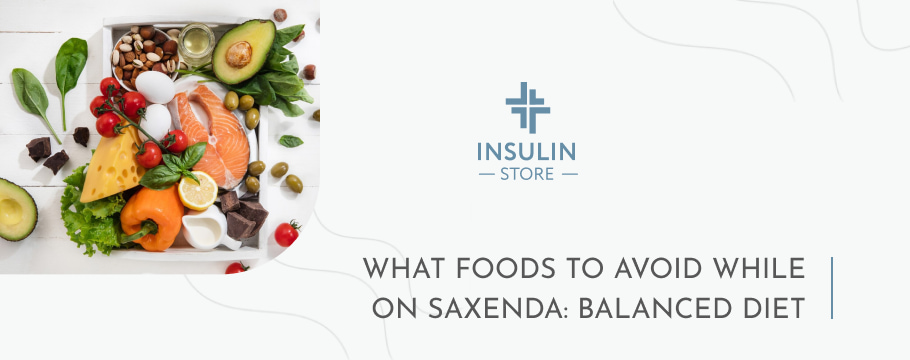
What Foods to Avoid While on Saxenda: Balanced Diet
Hoping for a weight loss miracle by taking Saxenda? It’s easy to believe that simply injecting this medication will lead to miraculous transformations without your additional effort. Saxenda injections might seem like the magic bullet, but the real secret lies in pairing this medication with a balanced diet and healthy lifestyle. It’s not just about the shots; it’s about smart eating and living too.
In this guide, we’ll break down the dos and don’ts of food to ensure Saxenda works for your weight loss goals. Let’s explore!
Saxenda Overview
Saxenda is a prescription medication manufactured by Novo Nordisk. Its active ingredient, liraglutide, mimics a hormone in the body called GLP-1, which helps regulate appetite and metabolism. Saxenda injections reduce appetite, support metabolic health, and slow stomach emptying. They promote feelings of fullness by activating GLP-1 receptors in the brain.
This medication is prescribed to adults with a BMI of 30 or higher, or those with a BMI of 27 or higher who have weight-related medical conditions like high blood pressure or type 2 diabetes. Saxenda is a part of a comprehensive weight management plan. It aids in the weight-loss journey. Saxenda improves metabolic health and reduces the risk of weight-related complications.
Kind reminder: Would you like to start your body transformation today? Buy Saxenda online on our website. We provide high-quality insulin-like products at an affordable price. Place your order and the parcel will be securely delivered to your doorstep.
What Foods to Avoid While on Saxenda
While Saxenda is an effective solution to lose weight, its efficacy can be significantly influenced by specific foods. Individuals can optimize their weight-loss journey and minimize the risk of adverse effects by steering clear of certain foods and maintaining a lower-calorie diet. Certainly, a person’s body responds differently to food, but there are general recommendations for a healthy diet. Here’s a closer look at foods to avoid while on Saxenda.
Sugary Foods
Examples: candies, cakes, ice cream, pastries, sugary cereals, sweetened beverages, or other sugary foods.
This kind of food can lead to blood sugar fluctuations and weight regain, undermining Saxenda’s ability to regulate glucose metabolism and promote weight loss.
Fatty Foods
Excess calorie intake of fast food or fat-packed meals may provoke excess weight, leading to obesity. When taking Saxenda, it’s advised to avoid these fat-rich foods:
- Fried Foods: fried chicken, french fries, onion rings, and fried appetizers.
- High-Fat Meats: fatty cuts of beef, pork, lamb, and processed meats like bacon and sausage.
- Fast Food: burgers, pizza, deep-fried items, and creamy sauces or dressings.
- Ultra-Processed Foods: packaged snacks, pastries, cakes, cookies, and other baked goods.
- Full-Fat Dairy: whole milk, cheese, butter, and cream.
Fat-rich foods are often calorie-dense, contributing to excess calorie intake, which may hinder weight loss progress and increase the risk of weight-related medical problems.
High-fat meals can delay gastric emptying and diminish feelings of fullness, potentially counteracting Saxenda’s ability to reduce appetite and promote satiety. Excessive intake of trans and saturated fats can lead to insulin resistance, dyslipidemia (elevated cholesterol), and cardiovascular disease, undermining Saxenda’s efforts to improve blood sugar levels and metabolic parameters. Foods high in saturated fats should be limited for heart health.
Salty Foods
This is food with a high sodium content, which can include various processed and packaged foods, as well as certain restaurant dishes.
- processed meats like bacon, sausage, and deli meats;
- canned soups and broths;
- snack foods such as chips, pretzels, and crackers;
- pickled vegetables like pickles;
- condiments like soy sauce, ketchup, and salad dressings;
- fast food items such as burgers, fries, and pizza;
- processed cheese and other dairy products.
While salt is an essential nutrient that plays a vital role in bodily functions, excessive intake of salty foods can have negative consequences when combined with certain health conditions or medication like Saxenda. It can contribute to high blood pressure and increase the risk of cardiovascular diseases like heart attack or stroke. Additionally, salty foods can cause fluid retention, leading to bloating and discomfort.
Alcohol
A frequently asked question is how much alcohol can be consumed when taking Saxenda. This product is generally permissible, but every patient should be mindful of moderate drinking. While taking Saxenda, moderate alcohol consumption is defined as up to one drink per day for women and up to two drinks per day for men.
However, remember that alcoholic beverages can be high in calories and may contribute to weight gain. Also, they may affect blood sugar levels and provoke hypoglycemia (low blood sugar). While there are no known direct medication interactions between Saxenda and alcohol, the last one can lead to dehydration. This may exacerbate the side effects of Saxenda, such as nausea.
Caffeinated drinks
Examples: coffee, tea, energy drinks, and certain sodas.
Different coffee and other drinks contain varying amounts of caffeine. It’s essential to be aware of the caffeine content of the beverages you consume to moderate your intake effectively. Caffeine is a diuretic, meaning it can increase urine production and potentially contribute to dehydration if consumed in excessive amounts. Staying adequately hydrated is vital for overall health and can support weight loss efforts. Additionally, these drinks can be sweetened or served with desserts, which can lead to high-calorie intake.
What Foods to Eat When Taking Saxenda to Lose Weight
Incorporate healthy eating with fewer high-calorie foods when taking Saxenda. Opt for natural sweeteners or sugar-free alternatives to satisfy cravings without compromising metabolic health. Replace sugary snacks with fresh fruits, berries, or unsweetened Greek yogurt for a nutritious and satisfying treat.
Aim to incorporate a variety of colorful fruits and vegetables into your reduced-calorie diet. These foods are low in calories and high in fiber, vitamins, and minerals.
Choose low-fat foods such as skinless poultry, fish, tofu, legumes, and lean cuts of meat to maintain protein levels. Choose sources of unsaturated fats such as avocados, nuts, seeds, and olive oils to provide essential fatty acids. Search for rich-fat dairy alternatives with lower calories. Replace refined grains with whole-grain bread or cereals, like quinoa, brown rice, oats, and whole wheat bread to boost fiber intake and support satiety. Eat foods to fulfill your energy.
Prepare homemade meals using fresh, wholegrain ingredients like vegetables, grains, and lean proteins to maintain a nutritious diet. Swap deep-fried options for grilled or backed alternatives, such as oven-baked chicken breast or roasted vegetables seasoned with herbs and spices. Choose whole, unprocessed foods and cook meals at home using minimal salt.
Pay attention to portion sizes and avoid oversized servings. Eat smaller meals, but more frequently throughout the day, preventing overeating. Eat slowly to gauge your level of satiety.
These can help to maintain a calorie-controlled diet while on Saxenda and support weight loss medication.
Side Effects of Saxenda
While Saxenda is an effective weight-loss medication, it may possess certain side effects that individuals should be aware of. These can range from mild to severe. The most common side effects among users may include stomach cramps, nausea, vomiting, diarrhea, constipation, redness, or itching at the injection site. Severe abdominal pain, infection, or allergy are rare. If any severe reaction occurs, it’s advised to contact the healthcare provider promptly.
Additionally, some individuals with a history of kidney disease, kidney failure, or thyroid cancer may need to exercise caution when taking Saxenda, as the medication could exacerbate these conditions. Furthermore, Saxenda is FDA-approved, and its injections are receptor agonist medications that influence appetite and metabolism.
It’s important to maintain a healthy relationship with food intake and develop good eating habits, focusing on specific foods with fewer calories that support overall well-being and provide essential nutrients. However, ultra-processed foods should be limited as they can contribute to weight gain, impaired glucose tolerance, and provoke some side effects.
Overall, individuals should discuss their medical history with a doctor to ensure Saxenda is a safe option.
How to Manage Low Blood Sugar
While taking Saxenda you have to monitor your glucose levels regularly and be aware of the signs and symptoms of hypoglycemia, such as sweating, trembling, and dizziness. Keep fast-acting carbohydrates, such as glucose tablets, fruit juice, or candy, to raise your blood sugar if it drops too low.
Always carry a blood glucose meter with you and check your levels as needed, especially before and after meals and physical activity. If you experience frequent episodes of low blood sugar, consult your doctor to adjust medication dosage and meal plan accordingly. Additionally, prioritize consistent meal timing and balanced nutrition to support weight management and stable blood sugar levels throughout the day.
Saxenda Injections for Weight Loss
While on Saxenda, pay attention to different aspects of your lifestyle, such as hydration, quality of food, sleep patterns, and stress management.
Incorporating healthy habits into your daily routine can complement the effects of Saxenda. This includes maintaining a calorie-controlled diet, prioritizing sufficient sleep, and nurturing your emotional well-being. By adopting these holistic approaches alongside Saxenda treatment, you can optimize your efforts and help to lose weight.
Conclusion
Saxenda injections can be a valuable tool in weight management but achieving lasting results requires more than just medication. Eating patterns, regular exercise, and emotional health are key components that support Saxenda’s results.
Being mindful of what foods to avoid while on Saxenda and making smart choices form up healthy body and lifestyle overall. Embrace the power of Saxenda alongside a nutritious diet to achieve your goals.
